Felix Baumgartner sinks to his knees and raises his arms after his successful dive from the stratosphere on Oct. 14, 2012. Credit: Red Bull Stratos.
Aerospace history was made as Austrian skydiver Felix Baumgartner set several records during an incredible heart-pounding jump from the stratosphere where he became the first person to travel faster than the speed of sound with just his body. Baumgartner was lifted aloft in a specially made capsule attached to one of the largest helium balloons ever used for human balloon flights. He jumped from approximately 39 km (39,045 meters, 128,100 feet, 24.26 miles) above the Earth, and now has the record for the highest jump, fastest jump and highest human balloon flight. He also broke the speed of sound, hitting an incredible Mach 1.24 or 1,342 km/h (833.9 miles per hour), in his dizzying descent. The previous record holder for three of those records was retired Air Force Col. Joe Kittinger, 84, — Baumgartner’s trainer, mentor and CAPCOM for the jump — who relayed words of encouragement throughout the ascent and helped Baumgartner go through his egress checklist. The only record of Kittinger’s that Baumgartner didn’t break was for the longest time in freefall. Baumgartner dropped for 4 minutes 20 seconds.
See a gallery of images below of the jump:
(This article was updated at 1:32 UTC on Oct. 15, 2012 to reflect verified data from Red Bull Stratos).
Baumgartner could be heard breathing heavily, but regularly, as he stepped onto the ledge of the capsule.
Just before he jumped, looking at the view of Earth below, Baumgartner said, “I wish the world could see what I can see. Sometimes you have to go really high to see how small you are.” He then dove feetfirst from the edge of the capsule.
Infrared cameras first picked up a small white dot falling through the sky, and soon the outline of Baumgartner was visible. Then, Baumgartner entered a spin, but he quickly was able to stabilize into a perfect freefall, bringing cheers from the Mission Control team from Red Bull Stratos.
Baumgartner could be heard talking during the entire freefall, but his words couldn’t always be made out. At one point he said his visor was fogging up, which had been a problem for much of the ascent inside the capsule. For some time during the ascent, there was discussion of aborting the jump because of the visor problem. But after much discussion and debate between Baumgartner and his team, the decision was made to go ahead with the jump.
As images appeared of Baumgartner falling under a fully deployed parachute, Kittinger radioed to his protege, “I couldn’t have done it better myself!”
While the goal of the jump was mainly to break records, the Red Bull Stratos team said today’s successful jump was a “big win for science,” as it collected valuable data to help improve safety for space travel and may even help with enabling high altitude bailouts from spacecraft that may be in danger.
Kittinger’s previous records were: Freefall from highest altitude: 31 km; fastest freefall: 988 km/h (614 mph); and longest freefall: 4 minutes 36 seconds, and so Kittinger still holds that record. The previous record for highest manned balloon flight was 34.66 km made by Victor Prather and Malcolm Ross in 1961.
All images are screenshots from the Red Bull Stratos webcast feed.
Screenshot of the webcast feed just minutes before Baumgartner jumped from the capsule.
Looking over Baumgartner’s shoulder inside the capsule as he goes through his checklist before the jump
Joe Kittinger and Felix Baumgartner go through the egress checklist to prepare for the jump.
Baumgartner’s view from the capsule just before he jumped.
Infrared view of Baumgartner during his freefall.
First non-infrared view of Baumgartner under his parachute.
Another view of Baumgartner under his unfurled parachute.
Baumgartner gets closer to the ground.
Baumgartner’s family cheers after they see the parachute has successfully deployed.

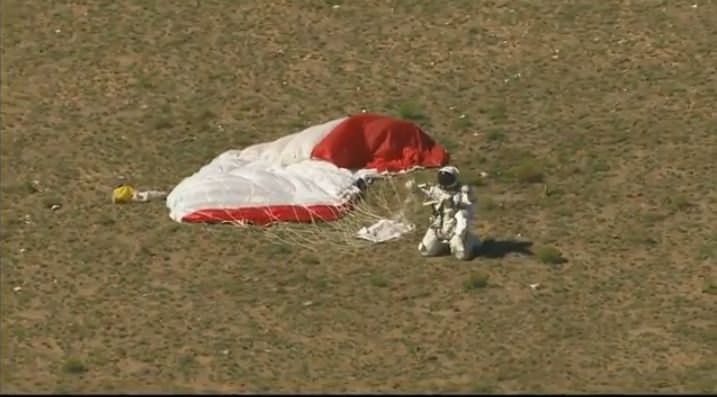
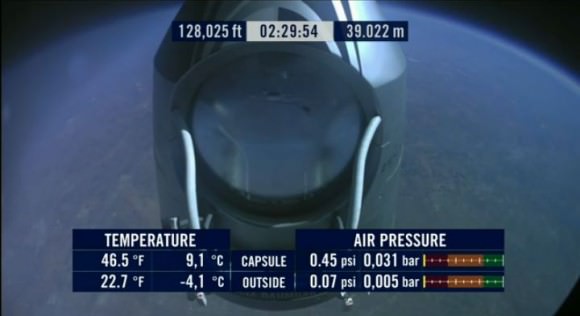
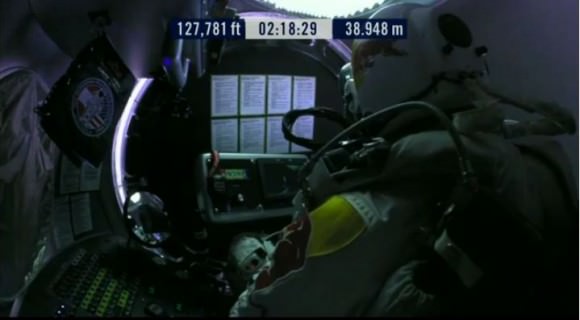
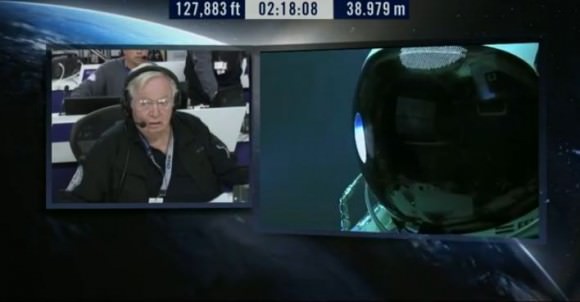
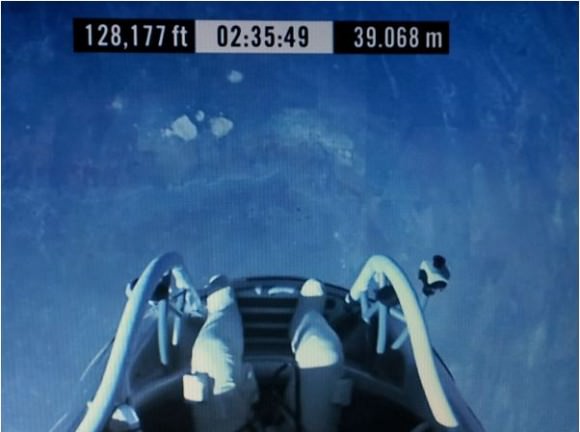
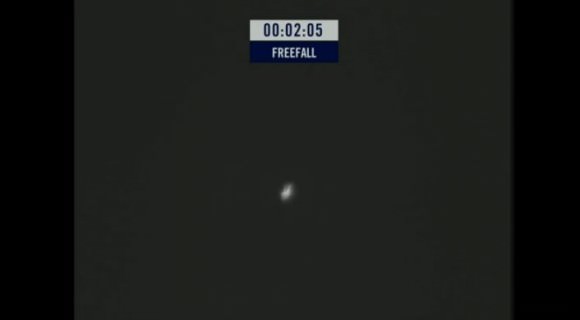
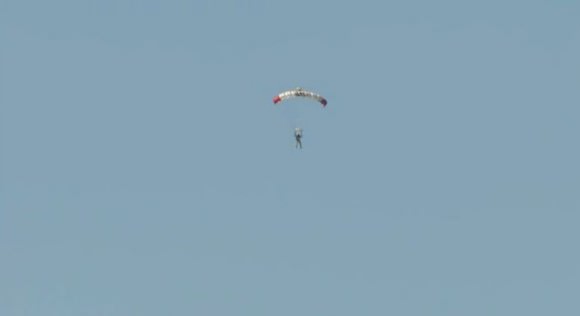
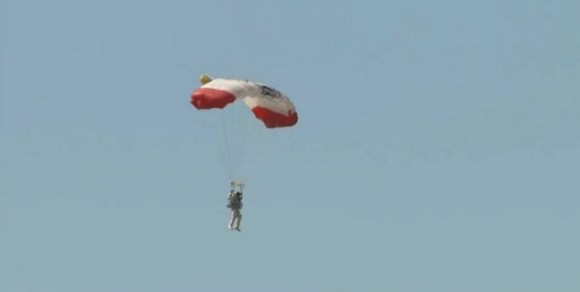
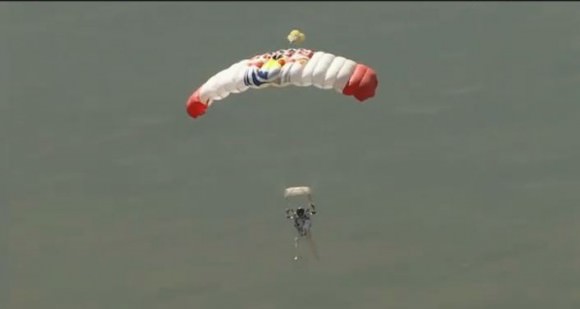

He must have really hairy cojones!
A coworker was wondering how he managed to fit into that small cabin with the required size of those things. 🙂
That was one of the coolest things I’ve ever had the pleasure to watch. I am still in awe. This must be what people felt like when they watched the moon landing.
Blew me away to watch this, though my internet locked up so had to view a Youtube someone posted (need to learn to leave a “thank you” msg to him/her.
I was nervous watching on this – can’t imagine how he felt, though he’s WAY above me with this stuff (I get butterflys in stomach before jumping off pool’s high dive). I kept watching for something to go wrong (balloon bursting on way up, hatch jamming, parachute not opening, even for the capsule breaking loose and landing on him after he was safe on the ground), but thankfully all went well (aside from his facemask heater, and I’m glad they all decided to continue with the mission). VERY glad Felix survived this – all the planning pays off, but things can still go wrong.
I was also blown away with the communications – various camera shots (esp of him standing on the edge before the jump), all the data being transmitted and displayed real-time for all to see. I saw the moon landing on TV, but this was almost like being there. Amazing.
One small step for man, one giant leap for product placement. Cool to watch though.
It was fantastic to watch… my heart was in my throat when he saluted, leaned over, and was GONE! Can’t wait til we get highlight footage! He had cameras on his suit, so there’s a lot more to come! Only thing is, with the world running out of Helium, filling a 55 storey high balloon full of the stuff is a BIT wasteful!!
Google ‘helium shortage’
It isn’t a matter of the world ‘running out’ of helium, but I’m not going to try to explain the recent change in the economics of it here…
From what I read previously, the world’s supply of helium was near depletion to the extent that the price of the gas would be raised to nearly impratical costs so as to limit its use for exclusively scientific or medical purposes (as a coolant). Been a lot of talk that proposed moon missions by Roscosmos and the Chinese space agency were aimed at determining the feasibility of setting up He3 extraction facilities on the lunar surface for just that reason. All probably conspiracy theorists tho :p
Incredible. This jump was one step shy of insanity, and yet he comes out of it unscathed. I was concerned that the shock wave created by breaking the sound barrier would break every bone in his body, but apparently the air pressure was too low when it happened. The reason he did not break the longest time in freefall despite the higher altitude I believe is due to the faster speed. I am glad that the team took the opportunity to take measurements throughout this jump which makes it more than just a stunt. For example safety methods can now be engineered from the data to allow low orbit astronauts or high altitude pilots to bail back to Earth without a vehicle, should that ever become necessary.
While I think it might be possible for someone as well trained as Felix to bail from a failed rocket at the apogee of an up and down flight where relative ground speed is low, the sort of circumstance for which this method might be desired, is more likely to occur while approaching near orbital speeds. That would call for some sort of de-orbit type burn of very large proportions to be performed by a craft that is already in trouble and possibly out of control. If it couldbe done it would also have to match ground speeds close enough and remain high enough above the atmosphere while decelerating to avoid being one crispy critter when re-entering. Not too likely when most spacecraft are designed to use atmospheric friction to re-enter, as both a fuel and weight saving technique. Inflatable heat-shields, anyone?
Quite Paul, most people don’t realise that Newton’s cannonball has to achieve around 17,000 mph horizontally before it stays up. That’s why nobody has yet put their iphone into permanent orbit.
That was terrific. There is no speed of sound in space. As he came down he needed a thick enough atmosphere to gain control. Did he go faster than the speed of sound without a shockwave and no sonic boom.
The initial drop out of the capsule was incredible. The speed of descent!
Quite amazing that such a thin yet quite large balloon carried the capsule to such dizzying heights. Camera views of the Earth were OTT. The technological expertise and precision exhibited by the entire team speaks volumes about the evolving human spirit. That this record occurred on the anniversary of Chuck Yeager’s record flight in 1947 makes this day all the more special.